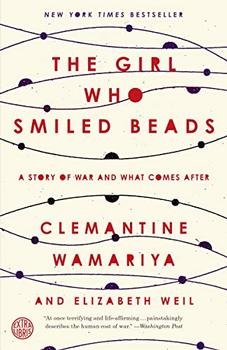Summary | Excerpt | Reviews | Beyond the Book | Read-Alikes | Genres & Themes | Author Bio

A Story of War and What Comes After
by Elizabeth Weil, Clemantine WamariyaThis article relates to The Girl Who Smiled Beads
Many of us remember reading about the events that Clemantine Wamariya experienced as a six-year-old girl in Rwanda in 1994, when over barely 100 days, Rwanda's Hutu ethnic majority went on a rampage, brutally murdering the ethnic Tutsi minority. The state-sponsored slaughter, a culmination of at least 30 years of unrest, took the lives of 800,000 of the Rawandan population of 7 million. It ended in July 1994 when the Rwandan Patriotic Front (RPF), a group primarily composed of ethnic Tutsis under Paul Kagame's leadership, took over the government. From that time on, Rwanda largely fell out of the news for most of us. So, here is a brief recap of events since then:
 Rwanda was in a terrible state immediately following the official halt of hostilities. Bodies littered the roads and clogged waterways and much of the country's infrastructure lay in ruins. Most government officials had died or fled, as had other individuals vital to the recovery effort, such as healthcare workers and police officers. Looters had emptied the banks leaving the national treasury completely bare, and there weren't enough people left to work what remained of the farms. The RPF had incarcerated approximately 120,000 people suspected of participating in the genocide, but a national atmosphere of anger and revenge persisted.
Rwanda was in a terrible state immediately following the official halt of hostilities. Bodies littered the roads and clogged waterways and much of the country's infrastructure lay in ruins. Most government officials had died or fled, as had other individuals vital to the recovery effort, such as healthcare workers and police officers. Looters had emptied the banks leaving the national treasury completely bare, and there weren't enough people left to work what remained of the farms. The RPF had incarcerated approximately 120,000 people suspected of participating in the genocide, but a national atmosphere of anger and revenge persisted.
Amazingly, less than 25 years later, Rwanda is well on its way to recovery. Economic growth has exceeded 8% per year in recent years, investment in the country has nearly tripled since 2005, and the World Bank listed Rwanda as the "World's Top Reformer" for business and entrepreneurs in their 2010 Doing Business report. From 2000 to 2015, Rwanda cut its child mortality rate in half, an accomplishment that UNICEF described as "one of the most significant achievements in human history."
Many attribute the country's ability to move forward to its government, led by President Paul Kagame, a Tutsi. Knowing that ethnic tensions remained, a four-pronged strategy was developed and implemented soon after the RPF took control, but accelerated after Kagame became president in 2000. Although the remaining Hutus were initially suspicious of the Tutsi-led government's plans, the process has shown itself to have significantly aided in healing the country's wounds.

While many credit Kagame's regime with Rwanda's success - both in keeping violence from re-erupting and in creating economic stability - the president has been criticized "for trampling on freedoms, building up the army to assert his authority, and using anti-genocide legislation to clamp down on opponents."
Update (6/19): Blood Papa: Rwanda's New Generation by Jean Hatzfeld provides a compelling look at contemporary life in Rwanda.
Images:
A view of contemporary Kigali, Rwanda's capital
A view of the Kigali Genocide Memorial
by Kim Kovacs
Filed under Places, Cultures & Identities
![]() This "beyond the book article" relates to The Girl Who Smiled Beads. It originally ran in May 2018 and has been updated for the
April 2019 paperback edition.
Go to magazine.
This "beyond the book article" relates to The Girl Who Smiled Beads. It originally ran in May 2018 and has been updated for the
April 2019 paperback edition.
Go to magazine.




Finishing second in the Olympics gets you silver. Finishing second in politics gets you oblivion.
Click Here to find out who said this, as well as discovering other famous literary quotes!
Your guide toexceptional books
BookBrowse seeks out and recommends the best in contemporary fiction and nonfiction—books that not only engage and entertain but also deepen our understanding of ourselves and the world around us.